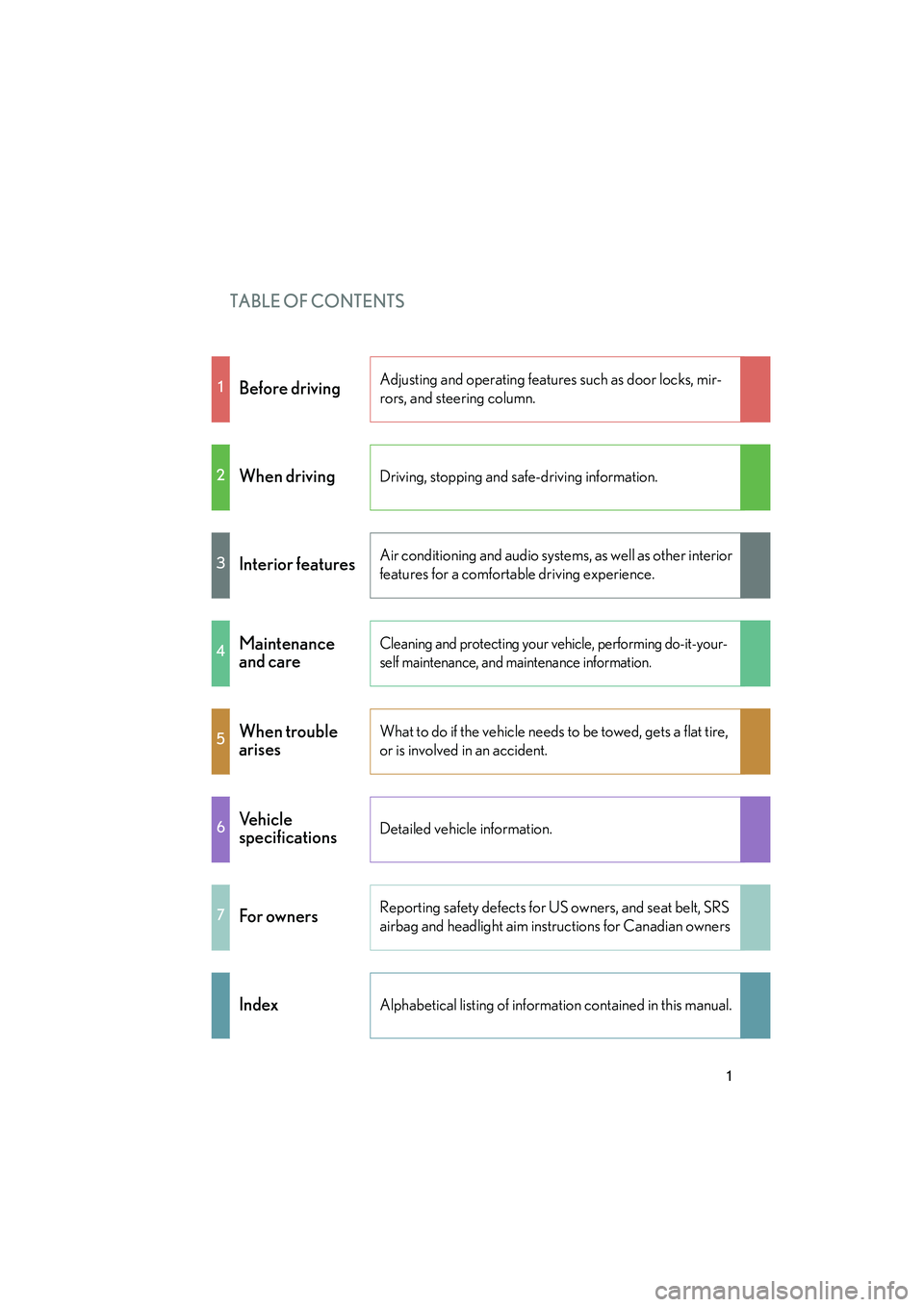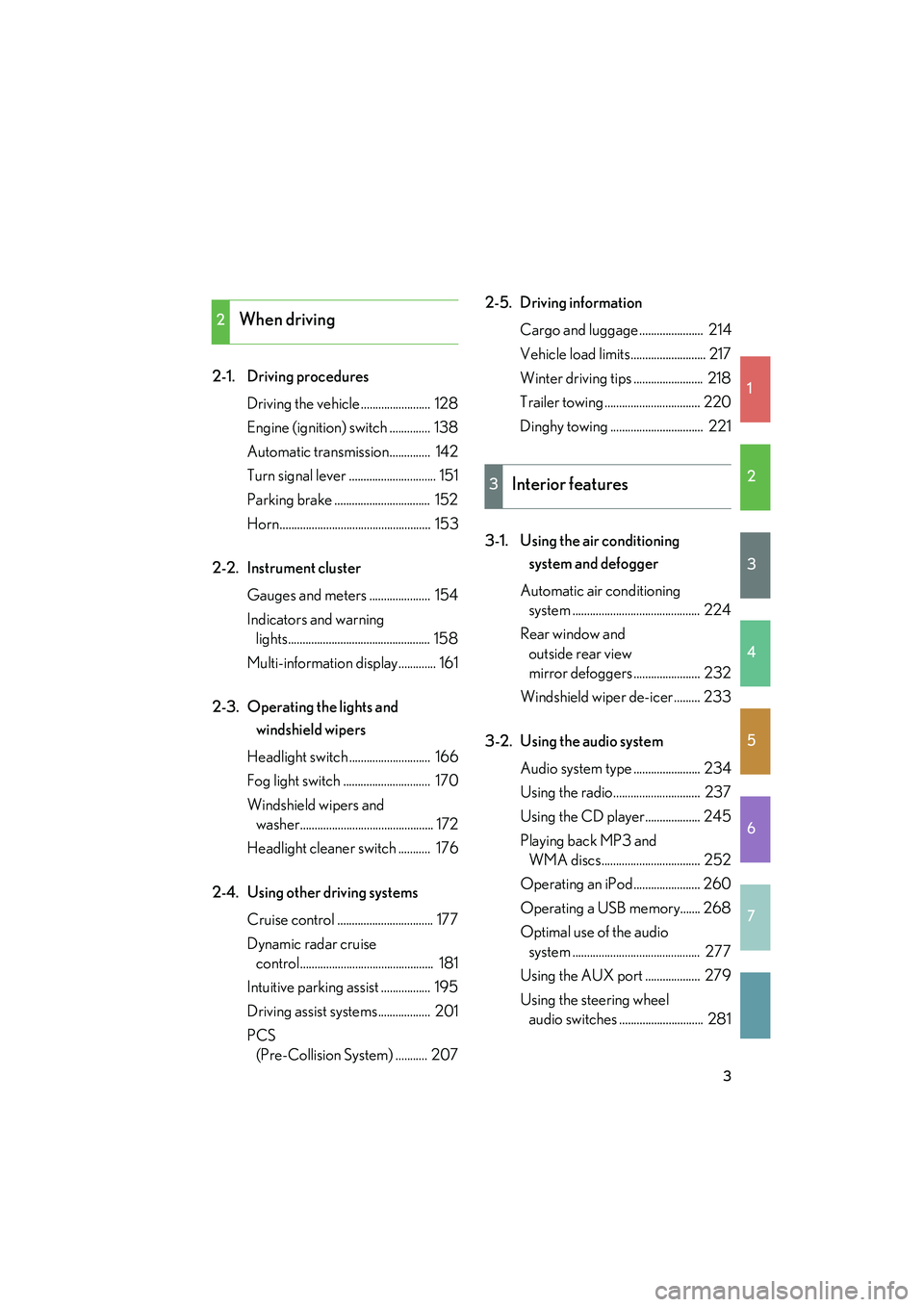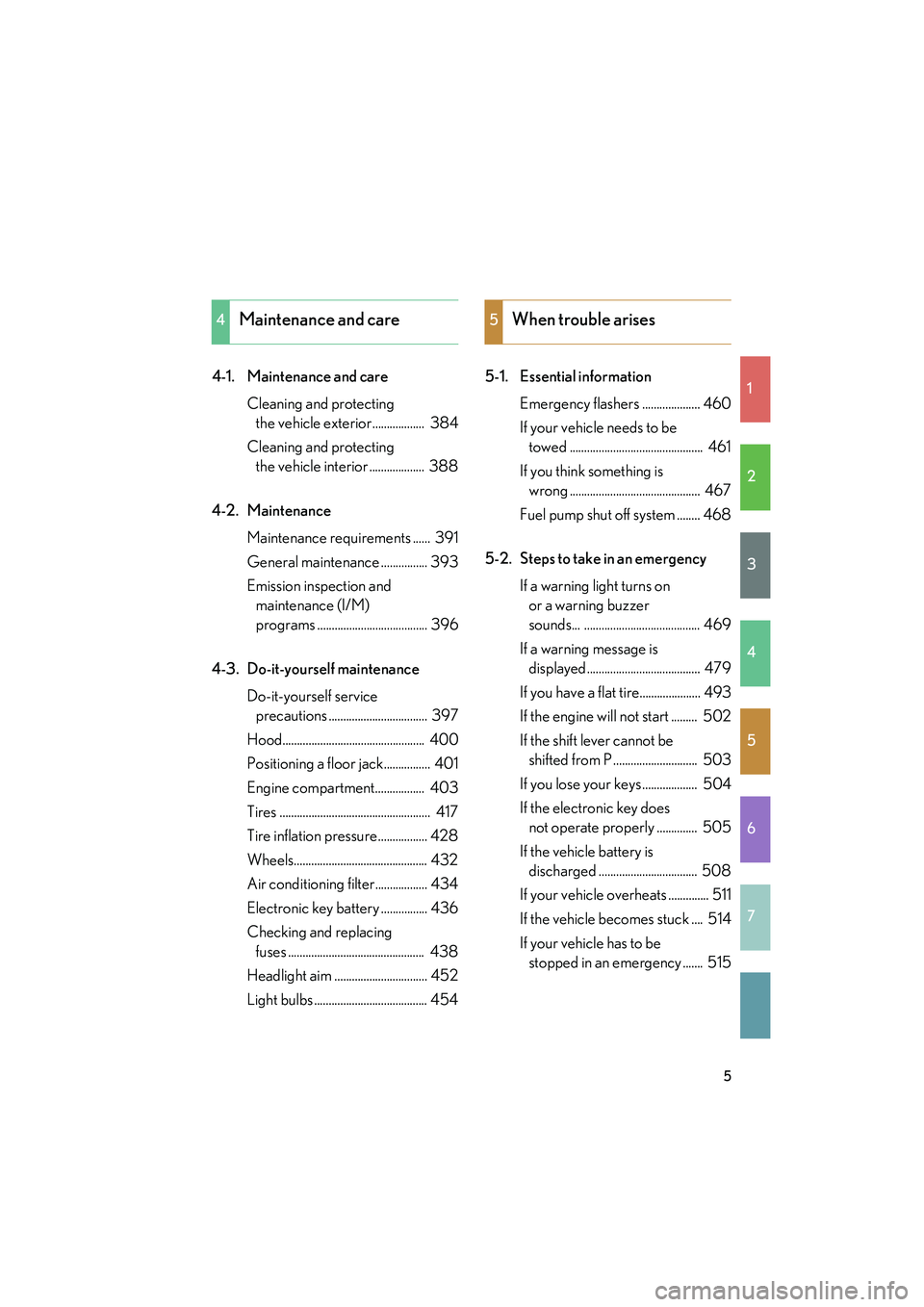tow Lexus IS F 2014 Owner's Manual
[x] Cancel search | Manufacturer: LEXUS, Model Year: 2014, Model line: IS F, Model: Lexus IS F 2014Pages: 586, PDF Size: 7.17 MB
Page 2 of 586

TABLE OF CONTENTS
IS F_U
1
1Before drivingAdjusting and operating features such as door locks, mir-
rors, and steering column.
2When drivingDriving, stopping and safe-driving information.
3Interior featuresAir conditioning and audio systems, as well as other interior
features for a comfortable driving experience.
4Maintenance
and careCleaning and protecting your vehicle, performing do-it-your-
self maintenance, and maintenance information.
5When trouble
arisesWhat to do if the vehicle needs to be towed, gets a flat tire,
or is involved in an accident.
6Ve h i c l e
specificationsDetailed vehicle information.
7For ownersReporting safety defects for US owners, and seat belt, SRS
airbag and headlight aim instructions for Canadian owners
IndexAlphabetical listing of information contained in this manual.
Page 4 of 586

1
2
3
4
5
6
7
3
IS F_U
2-1. Driving proceduresDriving the vehicle ........................ 128
Engine (ignition) switch .............. 138
Automatic transmission.............. 142
Turn signal lever .............................. 151
Parking brake ................................. 152
Horn.................................................... 153
2-2. Instrument cluster Gauges and meters ..................... 154
Indicators and warning lights................................................. 158
Multi-information display............. 161
2-3. Operating the lights and windshield wipers
Headlight switch ............................ 166
Fog light switch .............................. 170
Windshield wipers and washer.............................................. 172
Headlight cleaner switch ........... 176
2-4. Using other driving systems Cruise control ................................. 177
Dynamic radar cruise control.............................................. 181
Intuitive parking assist ................. 195
Driving assist systems.................. 201
PCS (Pre-Collision System) ........... 207 2-5. Driving information
Cargo and luggage ...................... 214
Vehicle load limits.......................... 217
Winter driving tips ........................ 218
Trailer towing ................................. 220
Dinghy towing ................................ 221
3-1. Using the air conditioning system and defogger
Automatic air conditioning system ............................................ 224
Rear window and outside rear view
mirror defoggers ....................... 232
Windshield wiper de-icer ......... 233
3-2. Using the audio system Audio system type ....................... 234
Using the radio.............................. 237
Using the CD player................... 245
Playing back MP3 and WMA discs.................................. 252
Operating an iPod....................... 260
Operating a USB memory....... 268
Optimal use of the audio system ............................................ 277
Using the AUX port ................... 279
Using the steering wheel audio switches ............................. 281
2When driving
3Interior features
Page 6 of 586

1
2
3
4
5
6
7
5
IS F_U
4-1. Maintenance and careCleaning and protecting the vehicle exterior.................. 384
Cleaning and protecting the vehicle interior ................... 388
4-2. Maintenance Maintenance requirements ...... 391
General maintenance ................ 393
Emission inspection and maintenance (I/M)
programs ...................................... 396
4-3. Do-it-yourself maintenance Do-it-yourself service precautions .................................. 397
Hood................................................. 400
Positioning a floor jack................ 401
Engine compartment................. 403
Tires .................................................... 417
Tire inflation pressure................. 428
Wheels.............................................. 432
Air conditioning filter.................. 434
Electronic key battery ................ 436
Checking and replacing fuses ............................................... 438
Headlight aim ................................ 452
Light bulbs ....................................... 454 5-1. Essential information
Emergency flashers .................... 460
If your vehicle needs to be towed .............................................. 461
If you think something is wrong ............................................. 467
Fuel pump shut off system ........ 468
5-2. Steps to take in an emergency If a warning light turns on or a warning buzzer
sounds... ........................................ 469
If a warning message is displayed....................................... 479
If you have a flat tire..................... 493
If the engine will not start ......... 502
If the shift lever cannot be shifted from P ............................. 503
If you lose your keys ................... 504
If the electronic key does not operate properly .............. 505
If the vehicle battery is discharged .................................. 508
If your vehicle overheats .............. 511
If the vehicle becomes stuck .... 514
If your vehicle has to be stopped in an emergency ....... 515
4Maintenance and care5When trouble arises
Page 37 of 586

36
1-2. Opening, closing and locking the doors and trunk
IS F_U
■Operation signals
A buzzer sounds and the emergency flashers flash to indicate that the doors have
been locked/unlocked. (Locked: Once; Unlocked: Twice)
■Conditions affecting operation
The smart access system with push-button start uses weak radio waves. In the fol-
lowing situations, the communication between the electronic key and the vehicle
may be affected, preventing the smart access system with push-button start from
operating properly:
(Ways of coping: →P. 505)
●When the electronic key battery is depleted
●Near a TV tower, electric power plant, gas station, radio station, large display,
airport or other facility that generates strong radio waves or electrical noise
●When carrying a portable radio, cellular phone, cordless phone or other wire-
less communication devices
●When the electronic key is in contact with, or is covered by the following metal-
lic objects
• Cards to which aluminum foil is attached
• Cigarette boxes that have aluminum foil inside
• Metallic wallets or bags
•Coins
• Hand warmers made of metal
• Media such as CDs and DVDs
●When multiple electronic keys are in the vicinity
●When another wireless key (that emits radio waves) is being used nearby
●When carrying or using the electronic key together with the following devices
that emit radio waves
• Another vehicle's electronic key or a wireless key that emits radio waves
• Personal computer or personal digital assistant (PDA)
• Digital audio player
• Portable game system
●If window tint with a metallic content or metallic objects are attached to the rear
window
Page 63 of 586

62
1-3. Adjustable components (seats, mirrors, steering wheel)
IS F_U
Head restraints
■Removing the head restraints (front seats)
Head restraints are provided for all seats.
Vertical adjustment (front seats)Up
Pull the head restraints up.
Down
Push the head restraint down
while pushing the lock release
button.
Folding operation (rear seats)
To stow the head restraint by
folding it forward, pull the head
restraint up while pushing the
lock release button. Only the
button on the right stay (when
facing the front of the vehicle)
can be used to fold the head
restraint forward.
Lock release button
Lock release button
Pull the head restraint up while pushing the
lock release button.
Lock release button
Page 65 of 586

64
1-3. Adjustable components (seats, mirrors, steering wheel)
IS F_U
■Adjusting the height of the head restraints
■When using the rear seat head restraints
Make sure the head restraints are not in the stowed/folded position while in use.
CAUTION
■Head restraint precautions
Observe the following precautions regarding the head restraints. Failure to do so
may result in death or serious injury.
●Use the head restraints designed for each respective seat.
●Adjust the head restraints to the correct position at all times.
●After adjusting the head restraints, push down on them and make sure they are
locked in position.
●Do not drive with the head restraints removed.
Make sure that the head restraints are
adjusted so that the center of the head
restraint is closest to the top of your ears.
Page 73 of 586

72
1-3. Adjustable components (seats, mirrors, steering wheel)
IS F_U
Steering wheel
Auto tilt awayWhen the “ENGINE START
STOP” switch is turned OFF, the
steering wheel returns to its
stowed position by moving up and
away to enable easier driver entry
and exit.
Switching to ACCESSORY or
IGNITION ON mode will return
the steering wheel to the original
position.
The steering wheel can be adjusted to a comfortable position.
Up
Down
Away from the driver
Toward the driver
Page 104 of 586

103
1-7. Safety information
1
Before driving
IS F_U
CAUTION
■SRS airbag precautions
Observe the following precautions regarding the airbags.
Failure to do so may cause death or serious injury.
●The driver and all passengers in the vehicle must wear their seat belts properly.
The SRS airbags are supplemental devices to be used with the seat belts.
●The SRS driver airbag deploys with considerable force, and can cause death or
serious injury especially if the driver is very close to the airbag. The National
Highway Traffic Safety Administration (“NHTSA”) advises:
Since the risk zone for driver airbag is the first 2 - 3 in. (50 - 75 mm) of inflation,
placing yourself 10 in. (250 mm) from your driver airbag provides you with a
clear margin of safety. This distance is measured from the center of the steering
wheel to your breastbone. If you sit less than 10 in. (250 mm) away now, you can
change your driving position in several ways:
• Move your seat to the rear as far as you can while still reaching the pedalscomfortably.
• Slightly recline the back of the seat. Although vehicle designs vary, many drivers can achieve the 10 in. (250 mm)
distance, even with the driver seat all the way forward, simply by reclining the
back of the seat somewhat. If reclining the back of your seat makes it hard to
see the road, raise yourself by using a firm, non-slippery cushion, or raise the
seat if your vehicle has that feature.
• If your steering wheel is adjustable, tilt it downward. This points the airbag toward your chest instead of your head and neck.
The seat should be adjusted as recommended by NHTSA above, while still main-
taining control of the foot pedals, steering wheel, and your view of the instrument
panel controls.
Page 106 of 586

105
1-7. Safety information
1
Before driving
IS F_U
CAUTION
■SRS airbag precautions
●Do not sit on the edge of the seat or lean
against the dashboard.
●Do not allow a child to stand in front of the
SRS front passenger airbag unit or sit on
the knees of a front passenger.
●Do not drive the vehicle while the driver or
passenger have items resting on their
knees.
●Do not lean against the door, the roof side
rail or the front, side and rear pillars.
●Do not allow anyone to kneel on the pas-
senger seat toward the door or put their
head or hands outside the vehicle.
Page 128 of 586

When driving2
127
IS F_U
2-1. Driving proceduresDriving the vehicle.................. 128
Engine (ignition) switch ......... 138
Automatic transmission ........ 142
Turn signal lever ........................ 151
Parking brake ........................... 152
Horn ............................................ 153
2-2. Instrument cluster Gauges and meters ................ 154
Indicators and warning lights ......................................... 158
Multi-information display ...... 161 2-3. Operating the lights and
windshield wipers
Headlight switch ..................... 166
Fog light switch ........................ 170
Windshield wipers and washer ...................................... 172
Headlight cleaner switch ...... 176
2-4. Using other driving systems
Cruise control........................... 177
Dynamic radar cruise control ...................................... 181
Intuitive parking assist ........... 195
Driving assist systems ............ 201
PCS (Pre-Collision System) ...... 207
2-5. Driving information Cargo and luggage ................ 214
Vehicle load limits ................... 217
Winter driving tips .................. 218
Trailer towing .......................... 220
Dinghy towing.......................... 221